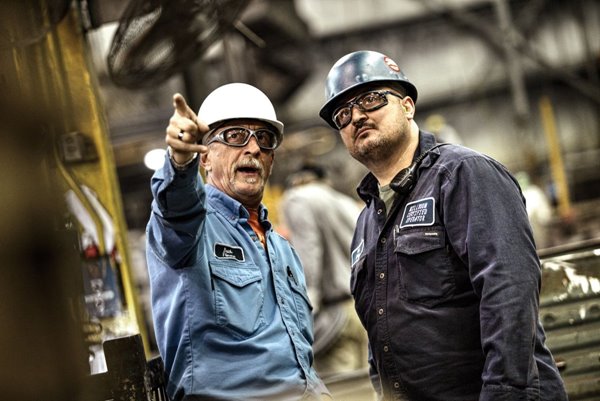Waupaca Foundry Wins Accolades for Green Efforts
When it comes to adding “green” technology to building projects, the concept seems to have gone from expensive buzzword to standard feature.
Companies are interested in sustainable and energy-saving technology both for the long-term cost advantage and because they see value in creating healthier work environments for their employees.
“Instead of being outside the norm, I want to believe that this is very much the norm,” says Tom Boldt, CEO of The Boldt Company. “This continues to be a high degree of interest for every customer, depending on their resources and their business.”
In general, prices for sustainable technology are coming down, partially because demand for LEED certified projects have increased and because the technology is simply becoming more cost effective.
“This is a very long-term trend,” says Mark Hanson, director of sustainable services for Hoffman Planning, Design & Construction, Inc. “Look at what a cellular phone would’ve cost you 20 years ago. Look at what you can get today. It’s that sort of similar technology development.”
Lower oil and gas prices are having mixed impact on projects. But because companies are becoming more concerned about health care costs, there’s a growing focus on renovating for corporate wellness — a branch of sustainability in terms of employee health, says Theresa Lehman, director of sustainable services for Miron Construction Co., Inc. Miron’s clients are asking for things like natural lighting and zero-VOC- (volatile organic compound) emitting carpets and paints.
A new ratings system by the International WELL Building Institute developed in partnership with the U.S. Green Building Council, called WELL, is adding momentum to the trend, aiming to eliminate toxic building materials. That’s become easier now that the cost of recycled and low- or zero-VOC materials has become comparable to building materials without these qualities.
“As a result, more of our clients are saying, ‘Well, that’s a no-brainer. Why would I intentionally not select materials that are healthy for my people at the same price as materials that are not healthy?’” Lehman says.
Overall, the cost of many LEED-certified projects with more sustainable features can be completed at the same or better cost of traditional construction, Hanson says.
“We’re working with a large client right now that wants to shrink their carbon footprint per person dramatically,” Hanson says. “That was their request right out of the box. That’s both fun and it’s unusual, but we’re maybe starting to see even more of our clients starting to look at that.”
Clients also are seeking more natural lighting as a way to help build productivity and make attractive interior environments. Even some manufacturers are building in more natural light. LED lighting is quickly replacing fluorescents as the preferred lighting choice, proving to be more cost effective. Some companies want to incorporate sustainability into their business so they can show both employees and customers that they take sustainability seriously, Boldt says.
“The thing that’s really neat about the industry is they’ve responded to the demand, so their basic products would be considered ‘green’ now, which is great,” Boldt says. “We’ve got so many more choices now.”
Waupaca Foundry is among manufacturers that have focused attention on improving efficiency, recently being accepted into the Wisconsin Green Tier program, which recognizes businesses that go above and beyond to meet or exceed environmental standards. (See “Waupaca Foundry wins accolades for green efforts”)
“The foundry industry is pretty competitive, and there’s a lot of international competition and pressure as well,” says Bryant Esch, sustainability officer for the foundry. “I think forward-thinking foundries know that energy use is one of their primary costs, and if they want to be lean and mean, they have to figure out how to use the energy more efficiently.”

Hoffman Planning, Design & Construction, Inc. designed the Affinity Clinic in downtown Neenah to incorporate natural light, and it also uses the highly efficient LED lighting in its interior. Clients are seeking energy-saving and sustainable features when they construct new or upgrade existing facilities. The long-term savings, and the decreasing cost of such features, makes them attractive to businesses. Photo courtesy of Hoffman Planning, Design & Construction, Inc.
In 2010, the company joined the Department of Energy’s voluntary program to save 25 percent of their energy within 10 years, one of a few in the nation. The foundry also hired a dedicated energy manager for the sole purpose of overseeing projects related to the program, Esch says.
About 70 percent of foundry sand by-products are now reused in local projects. It also reduced water use by 80 percent with a new closed-loop system, improved air quality monitoring and it developed a strong heat recovery system.
“We actually returned (waste heat) into the building for heating in the winter,” Esch says, “which, obviously, in Wisconsin, is a big deal.”
Construction companies also are upgrading their own buildings to be more efficient, provide a better working environment and to create a kind of showcase for their clients.
Hoffman recently completed an addition to its office in the City Center in Appleton and transitioned to LED lighting. Boldt upgraded its headquarters to silver-standard LEED certification, including an improved HVAC system, water savings, an energy-saving lighting system with reduced mercury and natural landscaping.
“We thought this would be a very good thing for us to do — it would be a learning experience for us, because most of the work that we have done is with new construction,” Boldt says.
Miron upgraded its own gold-LEED-certified headquarters a few years ago, adding a fitness center, a wellness director, more natural lighting, low-emitting VOC interiors and an air filtration system.
“People like coming to work because they say they feel better when they’re here,” Lehman says.

